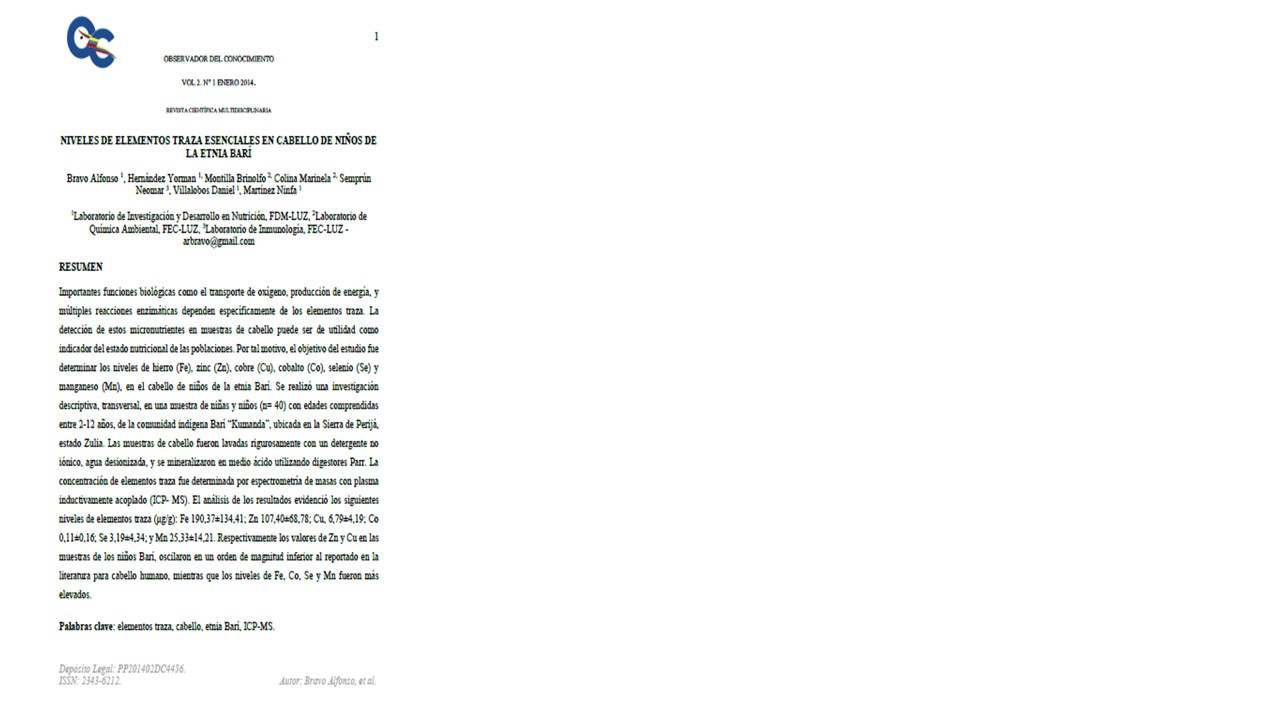Levels of Essential Trace Elements in Hair of Children of the Barí Ethnicity
Keywords:
Trace elements, hair, Barí ethnicity, ICP-MSAbstract
Important biological functions such as oxygen transport, energy production, and multiple enzymatic reactions depend specifically on trace elements. The detection of these micronutrients in hair samples can be useful as an indicator of the nutritional status of populations. For this reason, the objective of the study was to determine the levels of iron (Fe), zinc (Zn), copper (Cu), cobalt (Co), selenium (Se) and manganese (Mn), in the hair of children of the Barí ethnic group.
Downloads
References
Ali, M., Khan, H., Wahiduzzaman, M.; Malek, M. ( 1997). Trace element concentration in hair of Bangladesh children under normal and malnutrition conditions. Journal of Radioanalytical and Nuclear Chemistry, 219 (1), 81-87.
Barbieri, F.L.; Cournil, A.; Souza Sarkis, J. E.; Bénéfice, E.; y Gardon, J. ( 2011). Hair trace elements concentration to describe polymetallic mining waste exposure in Bolivian Altiplano. Biological Trace Elements Research, 139 (1), 10-23.
Bello, S.; Rodríguez, M.; Fernández, D.; Vásquez, A.; Ocando, A.; Contreras, J. y Granadillo, V. (2002). Niveles de mercurio en cabello de individuos expuestos ocupacionalmente en el área odontológica. Acta Odontológica Venezolana, 40 (2); 123-128.
Benson, O. (2011). Trace element indices in hair and saliva of school children. Journal Basic of Applied Sciences Research, 1 (3): 169-177.
Blaurock-Busch, E., Amin, O. R. y Rabah, T. (2011). Heavy metals and trace elements in hair and urine of a sample of Arab children with autistic spectrum disorder. Maedica, 6 (4): 247-257.
Blaurock-Busch, E., Amin, O. R., Dessoki, H. H. y Rabah, T. (2012). Toxic metals and essential elements in hair and severity of symptoms among children with autism. Maedica, 7 (1): 38-48.
Cordano, A. (1998). Clinical manifestations of nutritional copper deficiency in infants and children. American Journal of Clinical Nutrition, 67, 1012S-1016S.
Domellöf, M., Lönnerdal, B.; Dewey, K., Cohen, J., Rivera, L. Hernell, O. (2002). Sex Differences in Iron status during infancy. Pediatrics, 110: 545-552
Dongarrà, G.; Varrica, D.; Tamburo, E. D’Andrea, D. (2012). Trace elements in scalp hair of children living in differing environmental contexts in Sicily (Italy). Environmental Toxicology and Pharmacology, 34 (2): 160-169.
Galán, P.; Hercberg, S. (1989). El déficit del hierro en los países industrializados. Una carencia en el contexto de la abundancia (II). ROL de Enfermería, 135 (2), 69-73.
Gibson, R.S.; Hess, S.Y.; Hotz, C.; Brown, K.H. (2008). Indicators of zinc status at the population level: a review of the evidence. British Journal of Nutrition, 99 (3): 14-23.
Hernández Sampieri, R., Fernández Collado, C. Baptista, L.P. (2006). Metodología de la investigación. México: Mc Graw Hill.
Jiménez, C.; Marín, M. (1990). Aspectos nutricionales y toxicológicos de algunos elementos minerales: cobre, hierro, magnesio y zinc. Medicina Clínica, 94 (1), 59-84.
López Sánchez, R. y Hernández Rodríguez, C. (2004). Realidad actual de los pueblos indígenas de Venezuela: los Barí y los Yukpa y el conflicto con las empresas petroleras y carboníferas. UNICA, 5 (10), 122-144.
Manzini, J. L. (2000). Declaración de Helsinki: principios éticos para la investigación médica sobre sujetos humanos. Acta Bioethica, 6 (2): 321-334.
Maury, E., Mattei, A., Perozo, K., Bravo, A., Martínez, E. y Vizcarra, M. (2010). Niveles plasmáticos de hierro, cobre y zinc en escolares Barí. Pediatría (Asunción), 37 (2): 112-117.
Morton, J., Carolan, V. A. y Gardiner, P. H. E. (2002). Removal of exogenously bound elements from human hair by various washing procedures and determination by inductively coupled plasma mass spectrometry. Analytica Chimica Acta, 455 (1): 23-34.
Nicoloff, G.; Angelova, M.; Christova, I., Nikolov, A.; Alexiev, A. (2006). Serum cobalt in children with essential hypertension. American Journal of Human Biology, 18 (6): 798-805.
Nnorom, I., Igwe, J. y Ejimone, J. (2005). Multielement analysis of scalp hair samples from three distant towns in southeastern Nigeria. African Journal of Biotechnology, 4 (10), 1124-1127.
O’Donnell, A. Carmuega, E. (1998). La transición epidemiológica y la situación nutricional de nuestros niños [en línea]. Boletín CESNI, Argentina. Recuperado el 15 de julio de 2013, de http://www.cesni.org.ar/sistema/archivos/68-Volumen_6.pdf
Pombo, M., Castro, L. y Barreiro, J. (2001). El crecimiento, el desarrollo y los elementos traza. Anales Españoles de Pediatría, 54 (1): 63-71.
Portillo, C., Solano, L. y Fajardo, Z. (2004). Riesgo de deficiencia de macro y micronutrientes en pre- scolares de una zona marginal. Investigación Clínica, 45(1), 17-28.
Rodushkin, I. y Axelsson, M.D. (2000). Application of double focusing sector field ICP- MS for multielement characterisation of human hair and nails. Part I. Analytical methodology. Science of the Total Environment, 250: 83-100.
Rojas, M.; Nakamura, K.; Seijas, D.; Squillante, G.; Pieters, M. A.; Infante, S. (2007). Mercury in hair as a biomarker of exposure in a coastal Venezuelan population. Investigación Clínica, 48 (3), 305-315.
Sakai, T.; Wariishi, M.; Nishiyama, K. (2000). Changes in trace element concentrations in hair of growing children. Biological Trace Elements Research, 77(1), 43-51.
Solano, L.; Meertens, L.; Peña, E; Argüello, F. (1998). Deficiencia de micronutrientes. Situación actual. Anales Venezolanos de Nutrición, 11, 48-54.
Solano, L., Barón, M., Sánchez, A. y Páez, M. (2008). Anemia y deficiencia de hierro en niños menores de 4 años de una localidad en Valencia. Anales Venezolanos de Nutrición, 21 (2): 63-69.
SPSS Inc. (2011). IBM SPSS Statistics 20.0, [software de computadora en disco]. Chicago, EEUU.
Tasneem, G.; Hassan, A.; Naveed, K.; Mohammad, J.; Mohammad, A.; Nussarat J.; Ghulam, K. (2009). Copper, chromium, manganese, iron, nickel, and zinc levels in biological samples of diabetes mellitus patients. Biological Trace Elements Research, 122: 1-18.
Werner, J. (1992). Selenio, un elemento esencial y tóxico. Datos de Latinoamérica. Archivos Latinoamericanos de Nutrición, 42 (2), 90-93.
Yáñez, J.; Fierro, V.; Mansilla, H.; Figuero, L.; Cornejoc, L.; Barnes, R. M. (2005). Arsenic speciation in human hair: a new perspective for epidemiological assessment in chronic arsenicism. Journal of Environmental Monitory, 7, 1335-1341.

Downloads
Published
How to Cite
Issue
Section
License

This work is licensed under a Creative Commons Attribution-NoDerivatives 4.0 International License.







